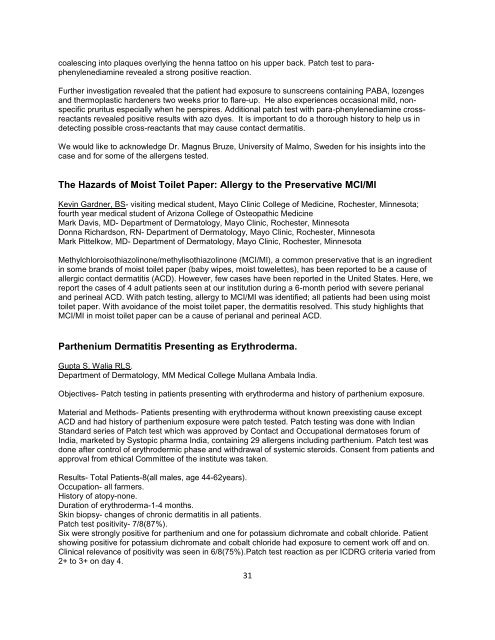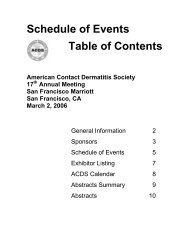American Contact Dermatitis Society 21 Annual Meeting
American Contact Dermatitis Society 21 Annual Meeting
American Contact Dermatitis Society 21 Annual Meeting
Create successful ePaper yourself
Turn your PDF publications into a flip-book with our unique Google optimized e-Paper software.
coalescing into plaques overlying the henna tattoo on his upper back. Patch test to paraphenylenediamine<br />
revealed a strong positive reaction.<br />
Further investigation revealed that the patient had exposure to sunscreens containing PABA, lozenges<br />
and thermoplastic hardeners two weeks prior to flare-up. He also experiences occasional mild, nonspecific<br />
pruritus especially when he perspires. Additional patch test with para-phenylenediamine crossreactants<br />
revealed positive results with azo dyes. It is important to do a thorough history to help us in<br />
detecting possible cross-reactants that may cause contact dermatitis.<br />
We would like to acknowledge Dr. Magnus Bruze, University of Malmo, Sweden for his insights into the<br />
case and for some of the allergens tested.<br />
The Hazards of Moist Toilet Paper: Allergy to the Preservative MCI/MI<br />
Kevin Gardner, BS- visiting medical student, Mayo Clinic College of Medicine, Rochester, Minnesota;<br />
fourth year medical student of Arizona College of Osteopathic Medicine<br />
Mark Davis, MD- Department of Dermatology, Mayo Clinic, Rochester, Minnesota<br />
Donna Richardson, RN- Department of Dermatology, Mayo Clinic, Rochester, Minnesota<br />
Mark Pittelkow, MD- Department of Dermatology, Mayo Clinic, Rochester, Minnesota<br />
Methylchloroisothiazolinone/methylisothiazolinone (MCI/MI), a common preservative that is an ingredient<br />
in some brands of moist toilet paper (baby wipes, moist towelettes), has been reported to be a cause of<br />
allergic contact dermatitis (ACD). However, few cases have been reported in the United States. Here, we<br />
report the cases of 4 adult patients seen at our institution during a 6-month period with severe perianal<br />
and perineal ACD. With patch testing, allergy to MCI/MI was identified; all patients had been using moist<br />
toilet paper. With avoidance of the moist toilet paper, the dermatitis resolved. This study highlights that<br />
MCI/MI in moist toilet paper can be a cause of perianal and perineal ACD.<br />
Parthenium <strong>Dermatitis</strong> Presenting as Erythroderma.<br />
Gupta S, Walia RLS.<br />
Department of Dermatology, MM Medical College Mullana Ambala India.<br />
Objectives- Patch testing in patients presenting with erythroderma and history of parthenium exposure.<br />
Material and Methods- Patients presenting with erythroderma without known preexisting cause except<br />
ACD and had history of parthenium exposure were patch tested. Patch testing was done with Indian<br />
Standard series of Patch test which was approved by <strong>Contact</strong> and Occupational dermatoses forum of<br />
India, marketed by Systopic pharma India, containing 29 allergens including parthenium. Patch test was<br />
done after control of erythrodermic phase and withdrawal of systemic steroids. Consent from patients and<br />
approval from ethical Committee of the institute was taken.<br />
Results- Total Patients-8(all males, age 44-62years).<br />
Occupation- all farmers.<br />
History of atopy-none.<br />
Duration of erythroderma-1-4 months.<br />
Skin biopsy- changes of chronic dermatitis in all patients.<br />
Patch test positivity- 7/8(87%).<br />
Six were strongly positive for parthenium and one for potassium dichromate and cobalt chloride. Patient<br />
showing positive for potassium dichromate and cobalt chloride had exposure to cement work off and on.<br />
Clinical relevance of positivity was seen in 6/8(75%).Patch test reaction as per ICDRG criteria varied from<br />
2+ to 3+ on day 4.<br />
31






